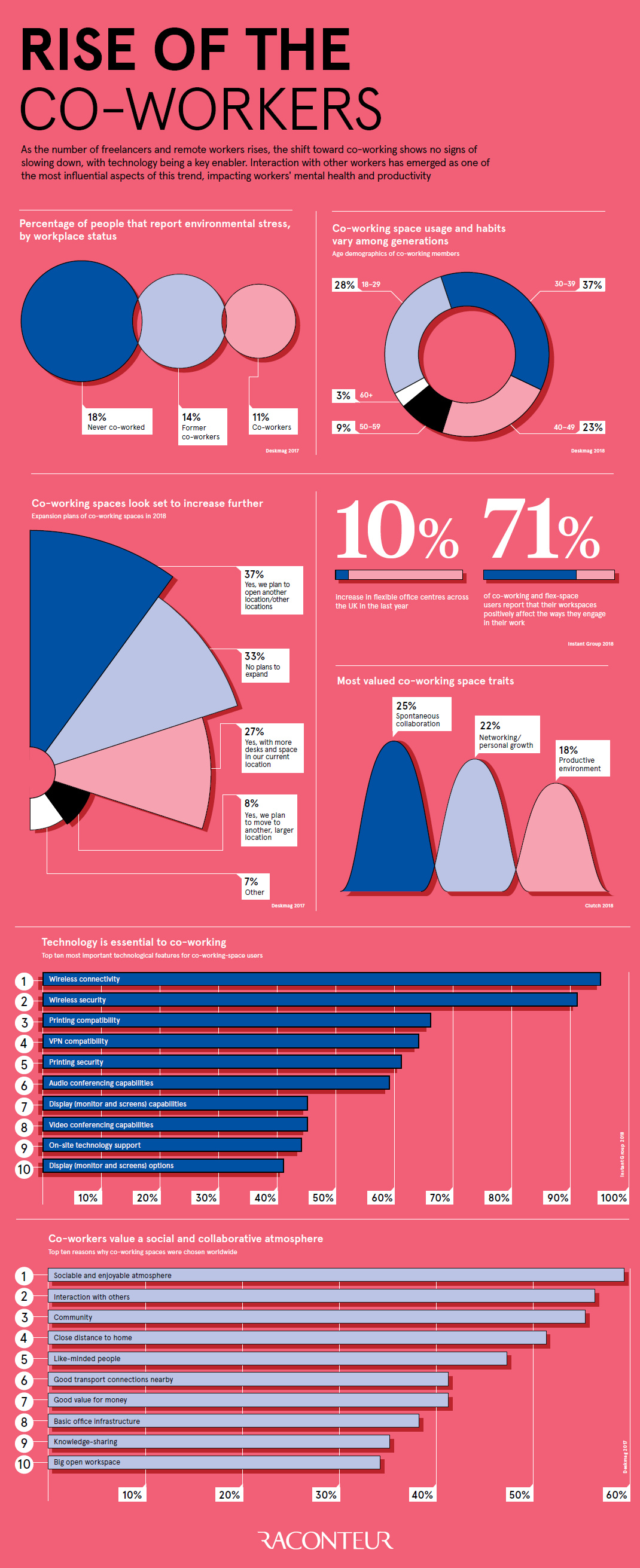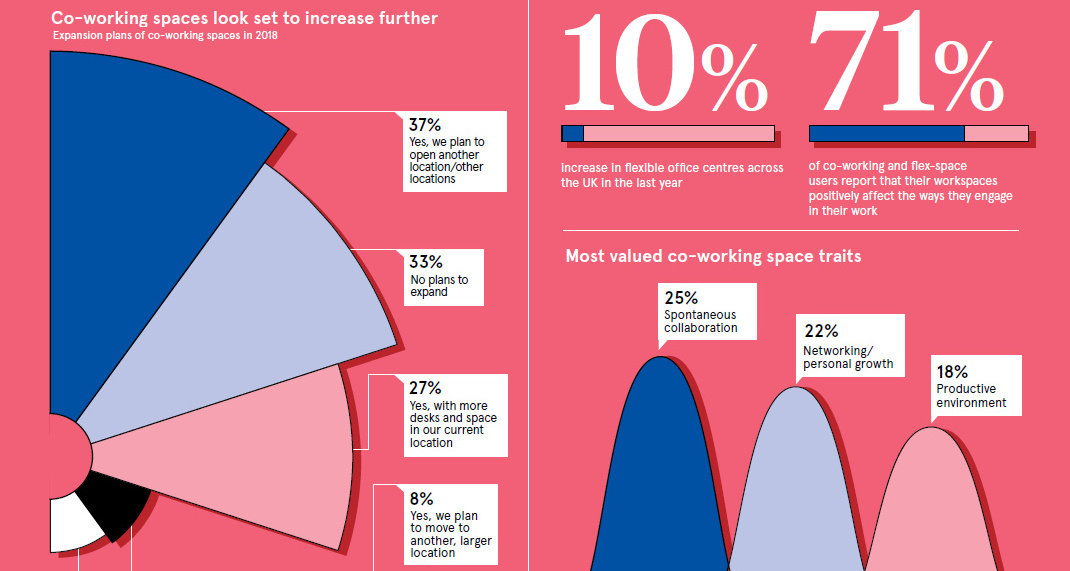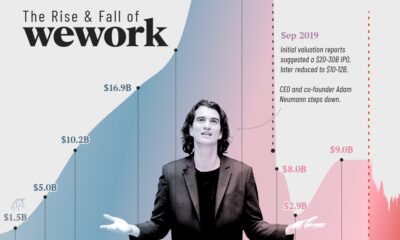Technology
Visualizing the Rise of Co-Working Spaces

Visualizing the Rise of Co-Working Spaces
In the modern era, people can work from anywhere and everywhere.
Thanks to the cloud, wireless protocols, and collaboration software, it’s possible for workers to be productive from a nearby coffee shop, another town, or a different country entirely.
While this unprecedented freedom allows us to work further apart, it’s simultaneously enabled a new business model that brings people together. The rise of co-working spaces – led by companies like WeWork – is already a multi-billion dollar industry, and a growing mainstay of startup culture.
Co-Working Together
Today’s infographic comes to us from Raconteur, and it shows why companies – and especially fast-growing startups – are increasingly gravitating towards co-working spaces.
The co-working industry offers something to startups that traditional solutions cannot, which is the ability for office space to scale with the company’s growth both seamlessly and flawlessly. Further, by covering all the essentials, from working wireless internet to an unlimited supply of coffee, this new model allows startups to focus on what matters, such as achieving product-market fit or the latest pivot.
The industry is expected to grow at a 12% CAGR over the next five years, and there’s even talk that segment-leading WeWork will be raising money at a $35 billion valuation.
Beyond the Value Prop
The prospect of “Space-as-a-Service” is certainly a compelling one for fast-growing startups, but what other valid reasons factor into the momentum behind co-working spaces?
According to co-workers themselves, here are the ten highest-ranking benefits of the model:
- Social and enjoyable atmosphere (59%)
- Interaction with others (56%)
- Community (55%)
- Close distance to my home (51%)
- Like-minded people (47%)
- Good value for money (41%)
- Good transport connections nearby (41%)
- Basic office infrastructure (38%)
- Knowledge-sharing (35%)
- Big open workspace (34%)
All in all, the value added by co-working spaces seems to be very real for the companies that call these shared spaces home.
As a result, it will be no surprise to learn that the global co-working industry is expected to expand to 30,432 spaces and 5.1 million members by 2022.
Technology
All of the Grants Given by the U.S. CHIPS Act
Intel, TSMC, and more have received billions in subsidies from the U.S. CHIPS Act in 2024.

All of the Grants Given by the U.S. CHIPS Act
This was originally posted on our Voronoi app. Download the app for free on iOS or Android and discover incredible data-driven charts from a variety of trusted sources.
This visualization shows which companies are receiving grants from the U.S. CHIPS Act, as of April 25, 2024. The CHIPS Act is a federal statute signed into law by President Joe Biden that authorizes $280 billion in new funding to boost domestic research and manufacturing of semiconductors.
The grant amounts visualized in this graphic are intended to accelerate the production of semiconductor fabrication plants (fabs) across the United States.
Data and Company Highlights
The figures we used to create this graphic were collected from a variety of public news sources. The Semiconductor Industry Association (SIA) also maintains a tracker for CHIPS Act recipients, though at the time of writing it does not have the latest details for Micron.
| Company | Federal Grant Amount | Anticipated Investment From Company |
|---|---|---|
| 🇺🇸 Intel | $8,500,000,000 | $100,000,000,000 |
| 🇹🇼 TSMC | $6,600,000,000 | $65,000,000,000 |
| 🇰🇷 Samsung | $6,400,000,000 | $45,000,000,000 |
| 🇺🇸 Micron | $6,100,000,000 | $50,000,000,000 |
| 🇺🇸 GlobalFoundries | $1,500,000,000 | $12,000,000,000 |
| 🇺🇸 Microchip | $162,000,000 | N/A |
| 🇬🇧 BAE Systems | $35,000,000 | N/A |
BAE Systems was not included in the graphic due to size limitations
Intel’s Massive Plans
Intel is receiving the largest share of the pie, with $8.5 billion in grants (plus an additional $11 billion in government loans). This grant accounts for 22% of the CHIPS Act’s total subsidies for chip production.
From Intel’s side, the company is expected to invest $100 billion to construct new fabs in Arizona and Ohio, while modernizing and/or expanding existing fabs in Oregon and New Mexico. Intel could also claim another $25 billion in credits through the U.S. Treasury Department’s Investment Tax Credit.
TSMC Expands its U.S. Presence
TSMC, the world’s largest semiconductor foundry company, is receiving a hefty $6.6 billion to construct a new chip plant with three fabs in Arizona. The Taiwanese chipmaker is expected to invest $65 billion into the project.
The plant’s first fab will be up and running in the first half of 2025, leveraging 4 nm (nanometer) technology. According to TrendForce, the other fabs will produce chips on more advanced 3 nm and 2 nm processes.
The Latest Grant Goes to Micron
Micron, the only U.S.-based manufacturer of memory chips, is set to receive $6.1 billion in grants to support its plans of investing $50 billion through 2030. This investment will be used to construct new fabs in Idaho and New York.
-

 Technology6 days ago
Technology6 days agoAll of the Grants Given by the U.S. CHIPS Act
-

 Uranium2 weeks ago
Uranium2 weeks agoThe World’s Biggest Nuclear Energy Producers
-

 Education2 weeks ago
Education2 weeks agoHow Hard Is It to Get Into an Ivy League School?
-

 Debt2 weeks ago
Debt2 weeks agoHow Debt-to-GDP Ratios Have Changed Since 2000
-

 Sports2 weeks ago
Sports2 weeks agoThe Highest Earning Athletes in Seven Professional Sports
-

 Science2 weeks ago
Science2 weeks agoVisualizing the Average Lifespans of Mammals
-

 Brands1 week ago
Brands1 week agoHow Tech Logos Have Evolved Over Time
-

 Energy1 week ago
Energy1 week agoRanked: The Top 10 EV Battery Manufacturers in 2023







